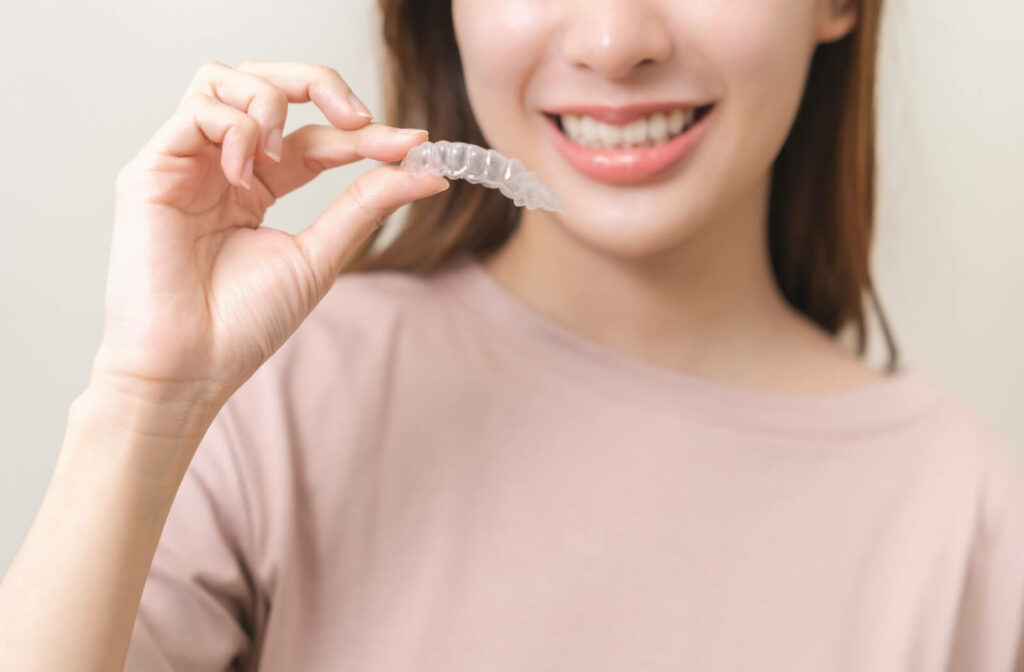In the quest for a perfect smile, many people find themselves choosing between traditional braces and Invisalign. Both options have their merits, and what suits one person may not suit another. This blog aims to clarify the differences between these two orthodontic options to help you make an informed decision for your oral health.
1. Appearance
Braces
Traditional braces consist of metal brackets that are securely glued to the surface of your teeth, connected by thin metal wires that apply pressure to gradually shift your teeth into the desired position. While traditional braces are effective and widely used, newer alternatives such as ceramic braces, which blend more naturally with the color of your teeth, and lingual braces, which are placed on the back side of your teeth for added discretion, offer a less visible option.
However, even with these advancements, braces still have a certain level of visibility that some individuals may find noticeable during close interactions. Each type of brace has its own set of advantages and considerations, making it important for patients to consult with their orthodontist to find the best fit for their needs.
Invisalign
Invisalign consists of clear, custom-made aligners that are nearly invisible when worn, making them an attractive option for individuals seeking a subtle approach to orthodontics. These aligners are specially designed using advanced 3D imaging technology to ensure a perfect fit for each patient, allowing for comfortable wear throughout the day. Unlike traditional metal braces, Invisalign aligners can be easily removed for eating, brushing, and flossing, promoting better oral hygiene.
This combination of discretion and convenience has made Invisalign a popular choice among teens and adults who wish to correct their teeth alignment without drawing attention to their treatment.
2. Comfort
Braces
Braces can sometimes cause discomfort due to their metal components, which can create pressure on the teeth as they’re gradually shifted into place. This discomfort may manifest as soreness or irritation inside the mouth, particularly after adjustments when the braces are tightened.
Additionally, the metal brackets and wires can sometimes rub against the soft tissues of the cheeks and gums, leading to irritation and even small sores. It’s important for individuals with braces to maintain good oral hygiene and consult their orthodontist if the discomfort becomes too severe or persistent.
Invisalign
Invisalign is generally considered more comfortable than traditional braces because the aligners are smooth and free of sharp edges that might cause irritation to the gums and cheeks. One of the significant advantages of Invisalign is that the aligners are removable, allowing users to take them out easily for eating, drinking, and brushing their teeth, which makes it much more convenient to maintain oral hygiene.
However, it’s important to note that some users may experience temporary discomfort or pressure when switching to a new set of aligners, as this is a sign that the aligners are effectively shifting the teeth into their new positions. This discomfort usually subsides within a few days as the mouth adjusts to the new aligners.
3. Duration of Treatment
Braces
The treatment time with braces can vary significantly from one individual to another, but it typically ranges from 18 months to 3 years. This duration largely depends on the complexity of each case, including factors such as the severity of the misalignment, age of the patient, and the specific orthodontic goals.
More complex cases may require additional time for the teeth to shift into their desired positions, while simpler cases may achieve results more quickly. Regular check-ups and adherence to the orthodontist’s recommendations can also influence the overall treatment duration.
Invisalign
Invisalign typically takes between 12 to 18 months to achieve noticeable results, depending on various factors such as the complexity of the dental issues being addressed and the patient’s commitment to wearing the aligners as prescribed.
It’s important to note that treatment time can be longer or shorter based on individual needs, as each person’s dental alignment journey is unique. Regular check-ins with your orthodontist can help monitor progress and make any necessary adjustments to ensure optimal results within the expected timeframe.
2. Comfort
Braces
Braces can sometimes cause discomfort due to their metal components, which can create pressure on the teeth as they’re gradually shifted into place. This discomfort may manifest as soreness or irritation inside the mouth, particularly after adjustments when the braces are tightened.
Additionally, the metal brackets and wires can sometimes rub against the soft tissues of the cheeks and gums, leading to irritation and even small sores. It’s important for individuals with braces to maintain good oral hygiene and consult their orthodontist if the discomfort becomes too severe or persistent.
Invisalign
Invisalign is generally considered more comfortable than traditional braces because the aligners are smooth and free of sharp edges that might cause irritation to the gums and cheeks. One of the significant advantages of Invisalign is that the aligners are removable, allowing users to take them out easily for eating, drinking, and brushing their teeth, which makes it much more convenient to maintain oral hygiene.
However, it’s important to note that some users may experience temporary discomfort or pressure when switching to a new set of aligners, as this is a sign that the aligners are effectively shifting the teeth into their new positions. This discomfort usually subsides within a few days as the mouth adjusts to the new aligners.
3. Duration of Treatment
Braces
The treatment time with braces can vary significantly from one individual to another, but it typically ranges from 18 months to 3 years. This duration largely depends on the complexity of each case, including factors such as the severity of the misalignment, age of the patient, and the specific orthodontic goals.
More complex cases may require additional time for the teeth to shift into their desired positions, while simpler cases may achieve results more quickly. Regular check-ups and adherence to the orthodontist’s recommendations can also influence the overall treatment duration.
Invisalign
Invisalign typically takes between 12 to 18 months to achieve noticeable results, depending on various factors such as the complexity of the dental issues being addressed and the patient’s commitment to wearing the aligners as prescribed.
It’s important to note that treatment time can be longer or shorter based on individual needs, as each person’s dental alignment journey is unique. Regular check-ins with your orthodontist can help monitor progress and make any necessary adjustments to ensure optimal results within the expected timeframe.

4. Cost
Braces
Traditional braces can be less expensive than Invisalign. However, the cost may vary based on the type of braces and the length of treatment.
Invisalign
Invisalign is generally more expensive due to the customization of the aligners and the advanced technology used. But financial plans often help make it more affordable.
5. Maintenance
Braces
Braces require regular maintenance and visits to the orthodontist for adjustments. Brushing and flossing can also be more challenging, necessitating special tools.
Invisalign
Invisalign aligners must be cleaned regularly to maintain hygiene. They should be removed before eating or drinking anything other than water, but they require fewer orthodontist visits than braces.
6. Eating Restrictions
Braces
With braces, certain foods are off-limits, such as sticky candies, hard nuts, and chewy snacks, as they can damage the brackets.
Invisalign
Invisalign aligners are removed for meals, so there are no eating restrictions. However, it’s essential to brush your teeth before putting them back in to avoid staining.
7. Effectiveness
Braces
Braces are highly effective for addressing a wide range of dental issues, including complex corrections like severely misaligned teeth and bite problems.
Invisalign
While Invisalign is effective for many cases, it might not be suitable for severe orthodontic issues. A consultation with an orthodontist will determine if Invisalign is right for you.
Ready for a New Smile?
Both braces and Invisalign offer unique benefits and drawbacks. If appearance and comfort are your priorities, Invisalign might be the best fit. However, if cost and effective treatment for complex cases is your primary concern, traditional braces might be more suitable.
Before making a decision, consult with one of our professionals at Belman Dental Centre to discuss your specific needs and preferences. Remember, the right choice is the one that aligns with your lifestyle and achieves your desired results.



